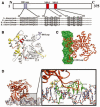Leishmania actin binds and nicks kDNA as well as inhibits decatenation activity of type II topoisomerase
- PMID: 20147461
- PMCID: PMC2879525
- DOI: 10.1093/nar/gkq051
Leishmania actin binds and nicks kDNA as well as inhibits decatenation activity of type II topoisomerase
Abstract
Leishmania actin (LdACT) is an unconventional form of eukaryotic actin in that it markedly differs from other actins in terms of its filament forming as well as toxin and DNase-1-binding properties. Besides being present in the cytoplasm, cortical regions, flagellum and nucleus, it is also present in the kinetoplast where it appears to associate with the kinetoplast DNA (kDNA). However, nothing is known about its role in this organelle. Here, we show that LdACT is indeed associated with the kDNA disc in Leishmania kinetoplast, and under in vitro conditions, it specifically binds DNA primarily through electrostatic interactions involving its unique DNase-1-binding region and the DNA major groove. We further reveal that this protein exhibits DNA-nicking activity which requires its polymeric state as well as ATP hydrolysis and through this activity it converts catenated kDNA minicircles into open form. In addition, we show that LdACT specifically binds bacterial type II topoisomerase and inhibits its decatenation activity. Together, these results strongly indicate that LdACT could play a critical role in kDNA remodeling.
Figures







Similar articles
-
Kinetoplast DNA Decatenation Assay with Eukaryotic Topoisomerase II.Methods Mol Biol. 2025;2928:197-204. doi: 10.1007/978-1-0716-4550-5_16. Methods Mol Biol. 2025. PMID: 40372647
-
TbKAP6, a mitochondrial HMG box-containing protein in Trypanosoma brucei, is the first trypanosomatid kinetoplast-associated protein essential for kinetoplast DNA replication and maintenance.Eukaryot Cell. 2014 Jul;13(7):919-32. doi: 10.1128/EC.00260-13. Epub 2014 May 30. Eukaryot Cell. 2014. PMID: 24879122 Free PMC article.
-
The SET and transposase domain protein Metnase enhances chromosome decatenation: regulation by automethylation.Nucleic Acids Res. 2008 Oct;36(18):5822-31. doi: 10.1093/nar/gkn560. Epub 2008 Sep 12. Nucleic Acids Res. 2008. PMID: 18790802 Free PMC article.
-
Kinetoplast as a potential chemotherapeutic target of trypanosomatids.Curr Pharm Des. 2008;14(9):847-54. doi: 10.2174/138161208784041051. Curr Pharm Des. 2008. PMID: 18473834 Review.
-
The structure and replication of kinetoplast DNA.Curr Mol Med. 2004 Sep;4(6):623-47. doi: 10.2174/1566524043360096. Curr Mol Med. 2004. PMID: 15357213 Review.
Cited by
-
Evidence for monomeric actin function in INO80 chromatin remodeling.Nat Struct Mol Biol. 2013 Apr;20(4):426-32. doi: 10.1038/nsmb.2529. Epub 2013 Mar 24. Nat Struct Mol Biol. 2013. PMID: 23524535 Free PMC article.
-
Over-Expression of Cysteine Leucine Rich Protein Is Related to SAG Resistance in Clinical Isolates of Leishmania donovani.PLoS Negl Trop Dis. 2015 Aug 21;9(8):e0003992. doi: 10.1371/journal.pntd.0003992. eCollection 2015 Aug. PLoS Negl Trop Dis. 2015. PMID: 26295340 Free PMC article.
-
Actin R256 Mono-methylation Is a Conserved Post-translational Modification Involved in Transcription.Cell Rep. 2020 Sep 29;32(13):108172. doi: 10.1016/j.celrep.2020.108172. Cell Rep. 2020. PMID: 32997990 Free PMC article.
-
Emerging Functions of Actins and Actin Binding Proteins in Trypanosomatids.Front Cell Dev Biol. 2020 Oct 9;8:587685. doi: 10.3389/fcell.2020.587685. eCollection 2020. Front Cell Dev Biol. 2020. PMID: 33163497 Free PMC article. Review.
References
-
- Hofmann WA. Cell and molecular biology of nuclear actin. Int. Rev. Cell Mol. Biol. 2009;273:219–263. - PubMed
-
- Louvet E, Percipalle P. Transcriptional control of gene expression by actin and myosin. Int. Rev. Cell Mol. Biol. 2009;272:107–147. - PubMed
-
- Farrants AK. Chromatin remodelling and actin organisation. FEBS Lett. 2008;582:2041–2050. - PubMed
-
- Liu B, Liu Y, Motyka SA, Agbo EE, Englund PT. Fellowship of the rings: the replication of kinetoplast DNA. Trends Parasitol. 2005;21:363–369. - PubMed
Publication types
MeSH terms
Substances
LinkOut - more resources
Full Text Sources
Molecular Biology Databases

